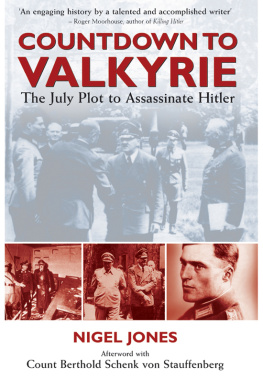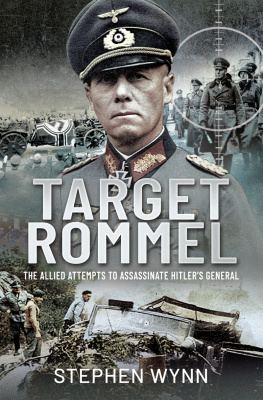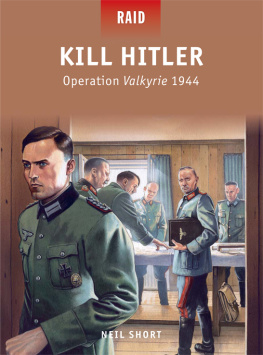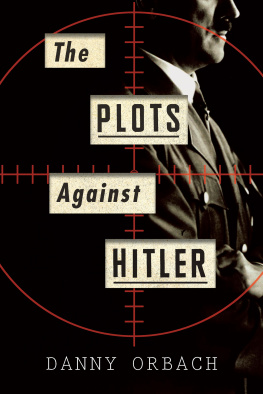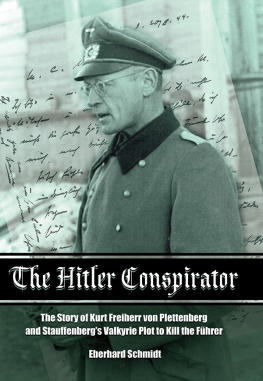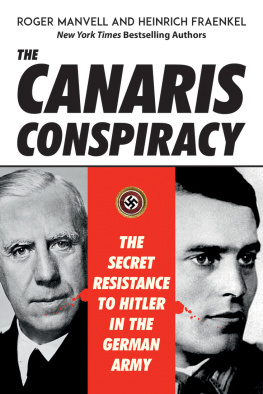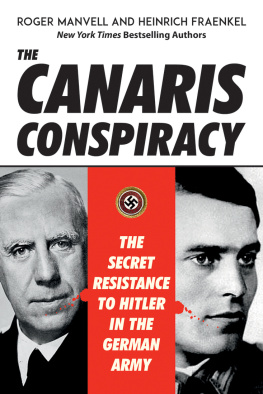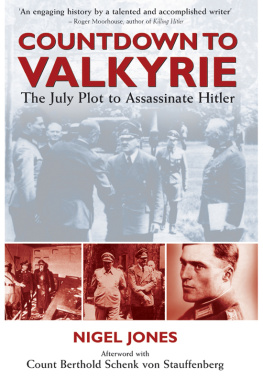
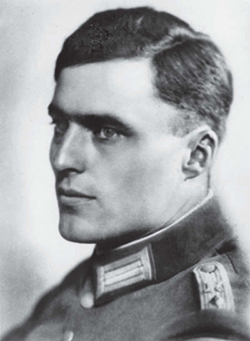
Count Claus Schenk von Stauffenberg, as a captain of the 6th Panzer Division.

For Liam, Tom, Alfie and Milena.

F RONTLINE B OOKS , L ONDON
Countdown to Valkyrie: The July Plot to Assassinate Hitler
This edition published in 2008 by Frontline Books, an imprint of Pen and Sword Books Ltd, 47 Church Street, Barnsley, S. Yorkshire, S70 2AS
www.frontline-books.com
Copyright Nigel Jones, 2008
ISBN: 978-1-84832-508-1
Digital Edition ISBN: 978-1-78346-145-5
The right of Nigel Jones to be identified as the author of this work has been asserted by him in accordance with the Copyright, Designs and Patents Act of 1988.
All rights reserved. No part of this publication may be reproduced, stored in or introduced into a retrieval system, or transmitted, in any form, or by any means (electronic, mechanical, photocopying, recording or otherwise) without the prior written permission of the publisher. Any person who does any unauthorized act in relation to this publication may be liable to criminal prosecution and civil claims for damages.
CIP data records for this title are available from the British Library and the Library of Congress
For more information on our books, please visit
or write to us at the above address.
Printed and bound in Great Britain by Biddles Ltd, Kings Lynn
Introduction
The story of the internal German resistance to Adolf Hitler and his National Socialist dictatorship, the hideous regime that he called the Third Reich, is a Classical Greek tragedy, containing all the elements required by Aristotle in his definition of the term. Its actors performed their deeds personally none more so than its legendary leader, the charismatic hero Count Claus Schenk von Stauffenberg and it encompassed terror, pity and fear in more than full measure.
By the time the anti-Nazi conspirators carried out the last and most spectacular of their several attempts to assassinate Hitler on 20 July 1944, they knew that their self-appointed mission was doomed to almost certain failure. For, even if they succeeded in outwitting the all-pervasive security of the SS state that Nazi Germany had become and hit their target, causing the violent death of the dictator, it was already too late to save the country they loved from defeat and destruction.
Just a few weeks previously, on D-Day, 6 June, the armies of the Anglo-American western allies, who previously had refused to encourage the plotters by agreeing to a separate peace deal excluding Russia, had swarmed onto the Normandy beaches and opened the long-awaited Second Front against Germany. The Fatherland was now living out the same nightmare it had faced in the First World War just twenty years before a war on two fronts. In the east, the seemingly inexhaustible divisions of Stalins Red Army were hurling themselves relentlessly against the crumbling defences of Hitlers realm. Each passing day brought their columns nearer to the heartland of the Reich, and by late July they were just a hundred miles away from Hitlers personally chosen eastern headquarters; the Wolfs Lair at Rastenburg, tucked away among the brooding, swampy forests of the East Prussian/Polish marches.
Almost every day and night now, fleets of American and British heavy bombers, virtually unopposed by the depleted remnants of Germanys once-mighty Luftwaffe, droned overhead and pounded the cities of the Reich, gradually grinding them into rubble. The news from the fronts moving ever closer that was brought to Hitlers twice-daily conferences with his military staff was almost uniformly bad. The perimeters of the Reich were shrinking, the losses of his armies could not be repaired or replaced, his remaining allies were searching for ways to desert him, and the inescapable truth was staring even the meanest intelligence in the face: Hitlers war was irretrievably lost.
But even though no move of theirs could affect the inevitable outcome of the war, the leading conspirators were more determined than ever that action should be taken. As one of the most clear-headed among them, General Henning von Tresckow, put it: The assassination must be attempted at all costs... what matters now is not the practical purpose of the coup, but to prove to the world and for the records of history that the men of the resistance movement dared to take the decisive step. Compared to this objective, nothing else is of consequence. In other words, it was not so much the practical purpose of an assassination and an associated putsch to overthrow the regime that mattered any longer: an assassination attempt was necessary to redeem the honour of the once-proud German army, a quality that had been surrendered on the snow-covered killing fields of Russia and eastern Europe long before.
Though opposition to Hitler and the barbaric policies he embodied long predated the outbreak of war and even his arrival in power in 1933, it was the actual murderous realisation of Nazi racial doctrines on the vast Russian steppes and hidden in the dense forests east of Warsaw that spurred some including Stauffenberg himself from mere grumbling into active anti-Nazi conspiracy. This radicalisation of the resistance was most marked among army officers who witnessed such atrocities as the massacre of Jewish communities and the slaughter of Slav sub-humans, both civilians and Soviet prisoners, and who gradually became aware of similar Nazi crimes inside Germany itself, including the euthanasia of the mentally and physically handicapped. Such flagrant trampling on the Christian ethics that had traditionally underpinned German society profoundly shocked the Prussian officer corps.
An activist minority of such men, however obedient to the head of state they may have been taught to be, held a higher loyalty to the laws of God, the teachings of Christ, or merely to codes of simple human decency. To restore the primacy of such higher commands, and to return Germany to the rule of law and the path of Christian civilisation, seemed to them the highest duty of all, outweighing soldierly concepts like obedience to their superiors orders and even the defence of their countrys borders against the enemy in wartime.
With military courage, determination and energy alas, not always matched by military efficiency the conspirators set about a final attempt to murder Adolf Hitler, the man to whom they had all pledged a compulsory oath of loyalty as their Fhrer, a leader combining the three posts of Commander-in-Chief of the armed forces, head of the government and head of state. In doing so, they were fully aware of what was at stake, and what they were putting at mortal risk. Failure would mean that the full fury of Nazi vengeance would be unleashed against them, with all that that entailed: arrest, imprisonment, cruel and prolonged torture, a humiliating public trial and a lonely, degrading death. Perhaps hardest of all to bear would be the reproaches of those of their fellow Germans, in whose name they claimed to be acting, who would accept the Nazis caricature of them as traitors who had stabbed their country in the back in its hour of greatest need. In the words of the Irishman Roger Casement, hanged for treason in the First World War, and equally revered in some quarters as a hero and reviled in others as a traitor: It is a cruel thing to die with all men misunderstanding.

